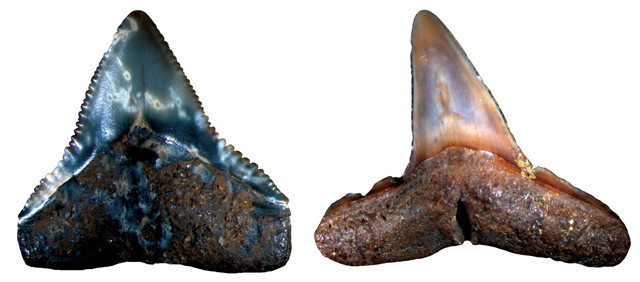
by Mary Caperton Morton Thursday, November 9, 2017

Fossils from Pliocene megafauna: sharks' teeth from Carchahinus leucas (left) and Negaprion (right). Credit: University of Zurich.
Extinctions of large land animals during the Pleistocene are well documented. In a new study, scientists report that marine megafauna also suffered severe losses several million years ago, around the time that the first hominid ancestors were emerging in Africa.
By examining the marine fossil record from the Pliocene and Pleistocene epochs, spanning 5.3 million to 11,700 years ago, researchers found that roughly “a third of marine megafauna disappeared about 3 [million] to 2 million years ago,” said lead author Catalina Pimiento of the Natural History Museum in Berlin, Germany, in a statement. “Therefore, the marine megafaunal communities that humans inherited were already altered and functioning at a diminished diversity.”
The extinction event disproportionally impacted large marine mammals, which lost more than 55 percent of their diversity. Sea turtles declined by as much as 43 percent, sea birds by 35 percent and sharks by 9 percent. In the study, published in Nature Ecology and Evolution, the team suggested that the losses may have been caused by declines in previously productive coastal habitats, caused by fluctuating sea levels, changing currents and other oceanographic factors.
“Our models have demonstrated that warm-blooded animals in particular were more likely to become extinct,” Pimiento said, including species of sea cows and baleen whales. “This study shows that marine megafauna were far more vulnerable to global environmental changes in the recent geological past than had previously been assumed.”
© 2008-2021. All rights reserved. Any copying, redistribution or retransmission of any of the contents of this service without the expressed written permission of the American Geosciences Institute is expressly prohibited. Click here for all copyright requests.